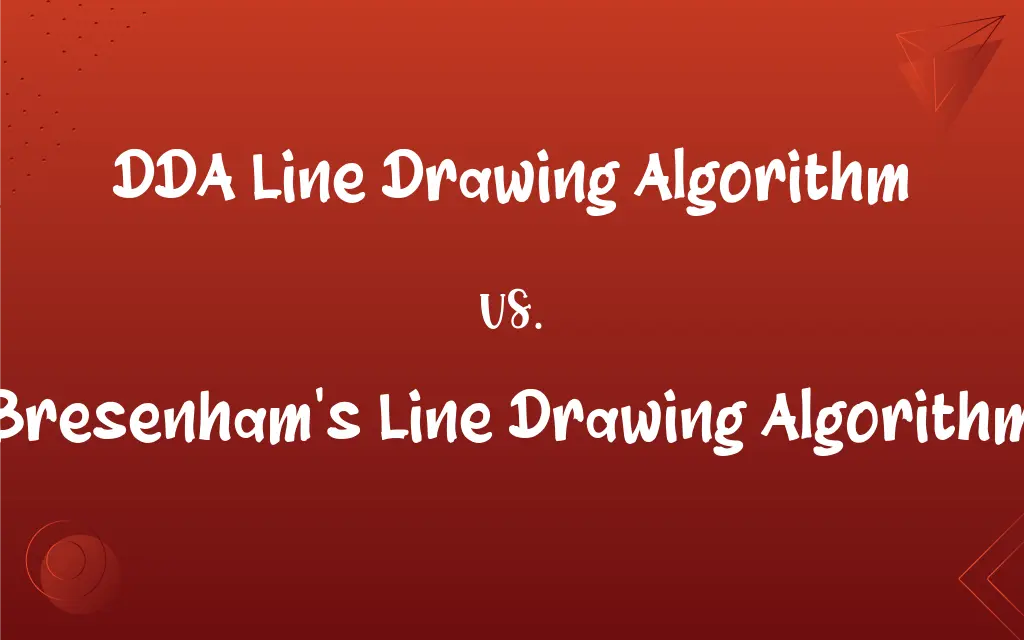DDA Line Drawing Algorithm vs. Bresenham’s Line Drawing Algorithm: What's the Difference?
Edited by Aimie Carlson || By Harlon Moss || Published on February 15, 2024
DDA Algorithm uses float arithmetic for line drawing, Bresenham's uses integer calculations for better efficiency and accuracy.

Key Differences
The Digital Differential Analyzer (DDA) algorithm uses floating-point or real arithmetic to calculate intermediate pixel positions, making it computationally intensive. Bresenham’s algorithm, on the other hand, uses integer arithmetic, which is more efficient and faster.
DDA is simpler in conceptual understanding and implementation but suffers from rounding errors and consumes more processing time. Bresenham’s algorithm is more complex but avoids rounding errors and is faster due to its use of integer arithmetic.
DDA calculates both x and y coordinates and plots points at unit intervals, making it less efficient for steep lines. Bresenham’s algorithm calculates only one coordinate and decides the next pixel based on a decision variable, making it more efficient.
In terms of performance, DDA is slower and can produce less accurate lines, especially at steep angles. Bresenham’s algorithm is faster and produces more accurate and visually pleasing lines.
DDA's use of floating-point arithmetic makes it more suitable for systems where processing power is not a constraint. Bresenham’s algorithm is ideal for systems where efficiency and accuracy are crucial, like computer graphics applications.
ADVERTISEMENT
Comparison Chart
Arithmetic Used
Floating-point or real arithmetic
Integer arithmetic
Complexity
Simpler to understand and implement
More complex, but more efficient
Rounding Errors
Susceptible to rounding errors
Avoids rounding errors
Efficiency and Speed
Less efficient, slower
More efficient, faster
Accuracy and Visual Quality
Less accurate, especially at steep angles
More accurate, produces better quality lines
ADVERTISEMENT
DDA Line Drawing Algorithm and Bresenham's Line Drawing Algorithm Definitions
DDA Line Drawing Algorithm
A simpler, more straightforward line drawing algorithm.
We chose the DDA algorithm for its simplicity in the initial stages of our graphics project.
Bresenham's Line Drawing Algorithm
An efficient line drawing algorithm using integer arithmetic.
Bresenham's algorithm was perfect for our high-speed graphics rendering task.
DDA Line Drawing Algorithm
A line drawing algorithm using real arithmetic to calculate pixel positions.
The DDA algorithm was used for drawing smooth lines in the application.
Bresenham's Line Drawing Algorithm
Ideal for raster devices due to its integer-based approach.
For pixel-perfect accuracy on the raster display, Bresenham's algorithm was the best choice.
DDA Line Drawing Algorithm
Involves incremental calculation of x and y coordinates on a line.
DDA's incremental approach ensures a complete line without gaps.
Bresenham's Line Drawing Algorithm
Produces accurate and visually pleasing lines, especially at steep angles.
In the game's engine, Bresenham's algorithm rendered sharp and clear lines.
DDA Line Drawing Algorithm
More computationally intensive due to floating-point operations.
The DDA algorithm's use of real numbers increased the computational load in our low-powered system.
Bresenham's Line Drawing Algorithm
Calculates only one coordinate, optimizing the line drawing process.
Using Bresenham's algorithm streamlined our line drawing routine, enhancing overall efficiency.
DDA Line Drawing Algorithm
Suitable for lines of all slopes and angles.
For the architectural design software, the DDA algorithm accurately rendered lines of various slopes.
Bresenham's Line Drawing Algorithm
Avoids floating-point calculations, reducing computational overhead.
We implemented Bresenham's algorithm to minimize processing time in the embedded system.
FAQs
Are floating-point operations used in DDA Algorithm?
Yes, it uses floating-point calculations for drawing lines.
What is the DDA Line Drawing Algorithm?
It’s a method for drawing lines using real arithmetic to calculate pixel positions.
Does DDA Algorithm work well for all line slopes?
Yes, it can draw lines of any slope but with less accuracy for steep slopes.
Is Bresenham’s Algorithm efficient for steep lines?
Yes, it is efficient and accurate for lines of any slope.
Is DDA suitable for graphic-intensive applications?
It can be used but is less efficient for such applications.
Does Bresenham’s Algorithm use floating-point calculations?
No, it exclusively uses integer calculations.
Can Bresenham’s Algorithm be used in embedded systems?
Yes, its efficiency makes it suitable for embedded systems.
Can DDA handle horizontal and vertical lines well?
Yes, it can handle both horizontal and vertical lines.
What is Bresenham’s Line Drawing Algorithm?
An algorithm for efficient line drawing using integer arithmetic.
What is the main advantage of Bresenham’s Algorithm?
Its main advantage is efficiency and accuracy in line drawing.
Is DDA more suitable for high-resolution graphics?
Not necessarily, as it can be less accurate at high resolutions.
Can Bresenham’s Algorithm be modified for circles?
Yes, it can be adapted for drawing circles and other shapes.
How does Bresenham’s Algorithm handle diagonal lines?
It handles them efficiently, with accurate pixel selection.
Do both algorithms produce visually similar lines?
Bresenham’s tends to produce more accurate and visually pleasing lines.
Is the DDA Algorithm easy to implement?
Yes, it has a simpler and more straightforward implementation.
Does Bresenham’s Algorithm require more memory?
No, it typically requires less memory than DDA.
Which algorithm is faster, DDA or Bresenham’s?
Bresenham’s Algorithm is generally faster due to integer arithmetic.
Does DDA Algorithm work on raster devices?
Yes, but Bresenham’s is often preferred for its accuracy.
About Author
Written by
Harlon MossHarlon is a seasoned quality moderator and accomplished content writer for Difference Wiki. An alumnus of the prestigious University of California, he earned his degree in Computer Science. Leveraging his academic background, Harlon brings a meticulous and informed perspective to his work, ensuring content accuracy and excellence.
Edited by
Aimie CarlsonAimie Carlson, holding a master's degree in English literature, is a fervent English language enthusiast. She lends her writing talents to Difference Wiki, a prominent website that specializes in comparisons, offering readers insightful analyses that both captivate and inform.































































